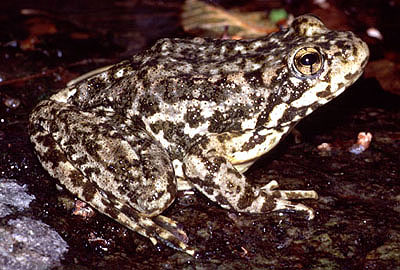We're open daily! View holiday hours
Science News
Frog Dehydration
April 26, 2012

It’s well known that the chytrid fungus causes a terrible disease that decimates amphibian populations—it has killed off more than 200 species across the globe. But how it does this is still being revealed.
Researchers at San Francisco State and UC Berkeley have a study in PLoS ONE this week that demonstrates that the fungus causes extreme dehydration in wild frogs, disrupting fluid and electrolyte balance, severely depleting the frogs’ sodium and potassium levels and causing cardiac arrest and death.
Their findings confirm what researchers have seen in carefully controlled lab experiments with the fungus, but SF State biologist Vance Vredenburg says the data from wild frogs provide a much better idea of how the disease progresses.
“The mode of death discovered in the lab seems to be what’s actually happening in the field,” he says, “and it’s that understanding that is key to doing something about it in the future.”
At the heart of the new study are blood samples drawn from mountain yellow-legged frogs by Vredenburg and colleagues in 2004, as the chytrid epidemic swept through the basins of the Sierras.
“It’s really rare to be able to study physiology in the wild like this, at the exact moment of a disease outbreak,” says UC Berkeley ecologist Jamie Voyles, the lead author of the study.
Unfortunately, it is a study that can’t be duplicated, at least not in the Sierras. Frog populations there have been devastated by chytrid, declining by 95 percent after the fungus was first detected in 2004.
“It’s been really sad to walk around the basins and think, ‘Wow, they’re really all gone,’” Vredenburg laments.
The chytrid fungus attacks an amphibian’s skin, causing it to become up to 40 times thicker in some instances. Since frogs depend on their skin to absorb water and essential electrolytes like sodium from their environment, Voyles and her colleagues knew that chytrid would disrupt fluid balance in the infected amphibians, but were surprised to find that electrolyte levels were much lower than anticipated for the Sierra Nevada sample.
Scientists want to learn as much as they can about how chytrid affects wild amphibians, with the hope that these findings will lead to better treatments for the infection. The new study suggests that individual frogs being treated for the infection might benefit from having electrolyte supplementation in the advanced stages of the disease.
Vredenburg and other researchers are already are experimenting with different ways of treating individual frogs, such as applying antifungal therapies or inoculating the frogs with probiotic bacteria that produce a compound that kills the fungus.
“The disease is not very hard to treat in the lab with antifungals. We know we can treat animals there,” Vredenburg says. “But in nature, the disease is still a moving target.”